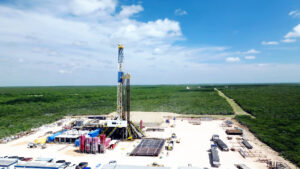Successfully drilling extended reach laterals requires the right combination of people, rig equipment and technologies.
Average lateral lengths in the Permian Basin more than doubled from 3,870 feet in 2010 to 10,064 feet in 2020. Today, some operators with the contiguous acreage are pushing the envelope further, choosing to drill more than 20,000 feet laterally.
Given the dynamic landscape, the capabilities of a drilling rig are more critical than ever.

Nabors rig operating in South Texas.
Challenges and Solutions
Drilling longer laterals presents inherent challenges. High operating torque, fluid systems, weight transfer, and wellbore quality, and the applicable technologies all become significant concerns as lengths extend beyond three miles.
Additionally, crews face the added responsibility of maintaining performance across safety and efficiency parameters, despite the longer lateral lengths, ensuring optimal operations in even the most demanding conditions.
Key Requirements for Longer Laterals
Some of the most important considerations start with the rig’s specifications, particularly the hook load, setback capacity and key equipment such as the top drive.
- Hookload: The rig needs to be capable of accommodating the additional weight on the mast from the longer drill string and casing designs.
- Setback: Adequate setback capacity is needed to support the maximum weight of drill pipe, casing and other tubulars when they need to be staged during drilling operations.
- Horsepower, Pressure and Torque: The top drive needs to provide enough torque and rotational force to overcome friction and sticking risks and maintain directional control.
Getting to total depth safely is only part of the equation. Advanced technologies such as process and machine automation, as well as logging-while-drilling (LWD) tools can ensure the crews maximize one-run laterals and wellbore quality, driving efficiency and productivity across the drilling, casing and completion operations.
Setting the PACE for Longer Laterals
Across all measures, Nabors PACE fleet of SmartRigs meet or exceed the needs of today’s operators pursuing longer lateral lengths.
With mast ratings ranging from 750,000 pounds to over one million pounds, setback capacities from 640,000 to over 900,000 pounds and Canrig® Top Drives that offer best-in-class torque and precision, the Nabors PACE fleet of SmartRigs are engineered for excellence. View the rig comparison for more details.
Nabors SmartSuite of automated drilling solutions enables crews to deliver consistent performance across well programs. This suite of directional and process automation delivers precise steering, reduces human error, improves safety and increases overall efficiency, which drive repeatable outcomes.
Combine Blue Force LWD and MWD systems and operators can get the biggest bang for choosing to go the extra mile on the lateral length. These systems enhance resource recovery, reduce non-productive time, improve safety and enable data-driven decision making.
Real World Examples
Nabors rigs in the Lower 48 are setting new benchmarks, particularly on challenging wells.
- In the Delaware Basin, a major operator achieved its fastest four-mile lateral using a Nabors rig.
- According to Hart Energy, Nabors has also drilled three of the longest laterals in the Permian Basin, stretching between 22,136 feet to 22,211 feet.
- Meanwhile, in the Eagle Ford, Nabors helped another leading operator successfully drill a single-run, four-mile lateral in just 14 days.
These accomplishments are just the beginning. Rig upgrades and continuous optimization efforts are already underway to further enhance capabilities.
As technology evolves and techniques improve, Nabors is well-positioned to continue leading the charge for those operators seeking to drill longer laterals.